Thanks for your support! If you make a purchase using our links in this article, we may make a commission. And, as an Amazon Associate, I earn from qualifying purchases. See the full disclosure here.
Updated April 19, 2024
This article is all about How to Clean and Flush Your RV Black Tank, and its Sensors in 3 Simple Steps which are:
- Drain your RV tank(s) at the dump site.
- Remove debris/buildup from the tank
- Add enough water to cover the bottom of your tank
Cleaning your RV’s black water tank and its sensors doesn’t have to be a dreadful experience. Routine washing can prevent bacteria build-up that leads to intense and unpleasant odors. Clogs are also much less frequent, leading to fewer complications and repairs.
When you’re enjoying a relaxing family camping trip, the last thing you want to worry about is an issue with your RV’s black water tank. To avoid this, follow our black water tank cleaning tips for your black water tank and its sensors.
- Should You Leave RV Black Tanks Open?
- How to Clean and Flush Your RV Black Water Tank
- Do RV Black Tank Treatments Help?
- Pressure Washing and Flushing to Clean Your RV Black Tank
- How Often Should You Flush Your Black Tank?
- Can You Put Bleach in an RV Black Water Tank?
- The Best RV Black Water Tank Flush System
- RV Black Water Tank Sensor Cleaning
- How Do RV Black Water Tank Chemicals Work?
- Do Black Water Tanks Require Special Toilet Paper?
- How Do You Clear A Blocked RV Black Tank Drain?
- What’s the Difference Between RV Black Water and Gray Water Holding Tanks?
- How Long Can You Leave Black or Gray Water in an RV?
- Final Words About How to Clean a RV Black Tank
- Related Reading:
- Mike Scarpignato – Bio
Should You Leave RV Black Tanks Open?
Leaving your black tank open is a disaster waiting to happen. While many people will leave their tank valves open when they are connected to a site with full hook-ups, this is never a good idea. In fact, it can cause more problems than you realize.
When you leave your black tank open, only the liquids leave the tank. This means that all of the solids will pile up in the tank. If they sit with the tank open long enough the solids will dry out and solidify in the tank.
The other problem that leaving your black tank valve open can cause is a pyramid plug. This is when the solids in your tank pile up in front of the outlet of the tank. Eventually, this plug will result in no liquids or solids being released from the tank. This could potentially back up into your RV.
The proper way to operate your black water tank is to keep the valve closed until the tank is full. Holding all of your waste in the tank until it is full or you intend on emptying will allow all of the solids and liquids to leave the tank. You reduce the risk of plugs or a build-up of solids in your tank.
How to Clean and Flush Your RV Black Water Tank
Flushing an RV tank is a pretty simple task. That said, it is also one of the most intimidating and unpleasant for those unfamiliar with it. After you’ve flushed your tanks a few times, it will become nothing more than a basic routine.
Here’s a run-down of how an RV tank flush works:
1. Drain The Tank
Connect your RV sewer hose to the dumping hole and the other end to the tank valve. Open the tank valve and allow the contents to flow into the sewer/septic.
It’s highly recommended to dump the black tank first, followed by the gray. The thought process is that the gray water helps to flush away some of the less than desirable black water debris and residue.
Keep in mind to dump your black tank when it’s at least halfway full (if not ⅔ of the way full). This allows waste and other solids to float and the liquids to drain properly. If you go to flush the tanks when the black tank is less than half full, be sure to add some extra water first.
2. Remove Debris/Buildup From Tank(s)
As lovely as it would be to merely dump your tanks and drive away, it isn’t quite that simple. When you flush your tanks, you need to perform some basic maintenance as well. This includes removing any debris or buildup that’s formed in the tanks.
You can do this in several different manners:
You Can Use a Macerator
A macerator uses high-velocity water pressure to shoot jets that clean the inside of the tanks and hoses to remove debris and buildup. The macerator basically liquifies any waste or build-up and allows it to be drained out of the tank like water.
You Can Use a Flush Valve
Another great tool for taking care of your tank is a flush valve. These valves connect a flush valve barrel to utility or garden hoses and allow you to choose from “hose” or “tank” settings. Backflow prevention is built-in to flush valves so that your clean water hose/source is never at risk of being contaminated.
You Can Use a Tank Rinser
Tank rinsers come in two versions. One that can be set into your tank each time you flush it, and one that can be installed into your tank permanently. Permanent rinsers rotate 360 degrees, shooting water at high pressures. Others come in wand-style hand-operated devices that connect to garden and utility hoses.
3. Add Enough Water to Cover the Bottom of Your Tanks
Tank flushing ends once you’ve dumped it, removed any debris or build-up, and filled up the bottom with water. This will help to keep your system functioning properly and avoid any damage.
Typically, four or five quarts of water will do the trick. Depending on the shape and size of your tanks, you may need to add more or less.
4. Treat Tank (Optional)
A fourth (and optional) step is treating the RV tanks you’ve just flushed. Treating tanks after dumping, flushing, and cleaning helps to prevent future buildup, clogs, and odors, as well as accelerate break-down time for future waste stored in the tank.
The black tank should be treated as close to every time you dump it as possible. The gray tank, on the other hand, isn’t necessarily one that needs to be treated each time you flush it.
Most tank treatments are quick and simple to use. That said, picking the best one can be a daunting task due to the large number of products on the market. Tank treatments that are enzyme-based, as well as formaldehyde-free, are the most preferred (as they are the safest and most efficient).
Do RV Black Tank Treatments Help?
Black tank treatments are a good option for maintaining your black water disposal system. These treatments come in a range of options including powders, packets, and liquids. These products contain chemicals, enzymes, and bacteria that break down waste. Breaking down the waste will help reduce the risk of blockages and tank back-ups.
Besides breaking down waste in your black water tank, treatment products can also help your RV waste system by controlling odors, digesting organic material, and keeping tank sensors clean. Some products also contain lubricants. Black water tank treatments with lubricants can also lubricate the seals and valves of your black water tank.
Tank treatments are a good way to help clean a RV black tank. Since you cannot get into your tank and scrub it, chemical and enzymatic treatments are the best way to clean and maintain your RV black tank.
Pressure Washing and Flushing to Clean Your RV Black Tank
After cleaning your tank in the manner described above, you’re ready to pressure wash or backwash the inside of the tank. Doing so will break off, soften, and liquidate any debris or waste matter. It is the final step to proper deep cleaning.
For the most part, this can be done in two different ways. First, with built-in backwash systems or via an RV tank cleaning wand:
Built-In System Directions
If your RV comes with a built-in backwash system, most of the time it’s as simple as connecting a garden or utility hose to the proper connection and flipping on the proper backwash or pressure washing valve (located on your RV).
Be sure to have the water running while backwashing the RV tanks. When you notice that the drainage has become clear, and is debris-free, you’re finished with your deep cleaning.
Using a Wand
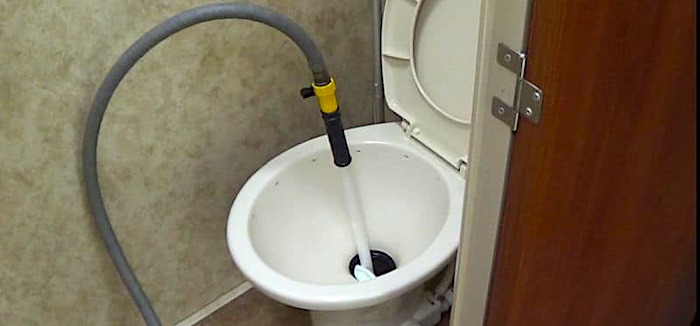
For RVers whose rigs have no backwash equipment built-in, there are a large number of RV tank cleaning wands and pressure washers available on the market. Similar to backwashing equipment, wands are attached to utility or garden hoses powered by water spouts at home or the camp/dump site.
To finish your deep cleaning with a wand, simply stick the wand down the open toilet lid and into the tank. Outside, have someone turn the water on, or turn it on yourself and then come back inside. Once the water is spraying from the wand, move it all around as to hit all of the nooks and crannies inside the tank.
Outside, again, someone should water the drainage until it is both free of debris and clear in color, at which point the job is finished.
How Often Should You Flush Your Black Tank?
There is no correct number of times per year, or how often, in general, you should flush your holding tanks. This number is based on multiple factors, such as how many people are using the tanks, and what size the tanks are, to begin with.
There is also the factor of how full you let your tanks get before you dump them. Many RVers swear by the 2/3s full rule, while others wait until their tanks are nearly completely full.
When traveling alone, or with one other person, you may get away with flushing your tanks once a week. If you’re RVing with a larger group, you may need to flush your tanks as much as every other day or so (or even daily).
Regular Maintenance Tips For Every Dump
There are a few maintenance tips to keep in mind each time you flush your tanks at a dumpsite:
- Make sure to wear some sort of protective gear, such as rubber gloves or a face mask
- Every time you flush your tanks, you should begin with your black tanks
- Take advantage of the soapy water from the gray tanks to clean black water residue
- Pack a spare (clean) hose along when you head to the dumpsite in case they don’t have any available
- Dump the black tank before the tank is over ⅔ of the way full
- Avoid using freshwater hoses for any type of black water tank or sewage hose rinsing
- Be courteous. If the dumpsite is busy, pull off and let someone else dump while you treat your tanks.
- Only dump tanks into the drainage pipes, and always clean up after yourself
- Make sure to clean the black-water valve before returning to camp
Deep Clean Tips For Monthly Cleaning and Before Storing Your RV
Here are a few deep clean tips that’ll make your monthly cleaning easier (and when you go to store your RV as well):
- Dumping as often as possible will make your deep cleaning and pre-storage cleaning processes much easier
- Deep cleaning once per week (while using the RV) will also make your deep cleaning and pre-storage tank cleaning quicker and more efficient
- For the best deep cleaning results, dump your tanks and remove debris as you would normally, and then drain the tanks completely
- After tanks are drained, fill them around ¾ of the way full and add bleach (two cups should do it in most cases – make sure to keep the toilet lid closed to avoid harmful fumes)
- After approximately 5 to 10 minutes, drain the tank again, refill it, and drain once more right away
- Repeat the process of filling the tank with fresh water and draining the tank until you see no debris or build-up is left, and the bleach smell has also disappeared completely
- It is important to rinse all of the bleach away so that it doesn’t damage your plumbing system)
Can You Put Bleach in an RV Black Water Tank?
Yes, you can put bleach into your RV’s black water and gray water tanks. That said, the amount of bleach and how often you should use it in each type of tank varies.
For black water tanks, many RVers mix anywhere from a few caps to a quarter of a cup of bleach with approximately a gallon of water. It is enough to get the job done, cleaning and sanitizing your tanks, but not enough to damage your plumbing or hoses. It is also safe to dispose of at the dump site.
Gray tanks can also be treated with bleach. One or two caps full of bleach can be added to the gray water tank for sanitizing purposes, including reducing bacteria and odors.
Very thoroughly rinsing tanks after using bleach in them is highly recommended, especially if you use a large amount (more than suggested above). High concentrations of bleach in your RV plumbing system can result in major damage.
The Best RV Black Water Tank Flush System
An RV black water tank cleaning wand is excellent for spraying down your holding reservoir. However, it can be tedious and cumbersome to direct the hose through the toilet each time.
The RhinoFLEX Rhino Blaster, on the other hand, is a durable, reliable alternative that can be stretched, retracted, and twisted while maintaining its form. This sturdy RV sewer hose is made from 23 mils of heavy-duty polyolefin and is equipped to fit your needs.
The adapter cuts down on time and energy while providing an in-depth cleaning experience. Many other RV sewer hoses are flimsy and difficult to use as they are vinyl-based. The RhinoFLEX is resistant to these damages because it is composed of polypropylene and polycarbonate.
With the black tank valve open, switch the valve to change the direction of water flow and connect a garden hose to the RV sewer hose. When the freshwater is turned on, its force will dislodge any obstructions and remove any residue stuck inside the container. A translucent elbow allows you to gauge when the tank is clean and ready to go.
We love ours because after we dump our black water tank, it takes much less time to refill the tank to give it a second flush. We used to have to sit inside the RV and run the hose and wand through the RV into the toilet or just run the toilet for a long time to refill the black tank.
Now we just use the water hose at the dump station and attach it to our RhinoFLEX Rhino Blaster and quickly and easily refill the black tank, and the wastewater goes right down the sewer hose.
RV Black Water Tank Sensor Cleaning
Fully functioning RV black water tank sensors are vital to the dumping process. If your sensor is faulty, it will signal that the tank is full or partially full after emptying your holding tank.
Small pieces of metal, also known as sensors, are located at 1/3, 2/3, and full increments. When the basin fills to each mark, the electrical circuit is completed, which turns on the RV monitoring panel light. This control pad indicates when you need to empty your tank.
When the sensors stay lit even after dumping, excess residue or waste stuck to the black water tank is usually the root cause.
To fix this issue, fill the holding tank with water and add high-quality sensor cleaner to the toilet. The container label should instruct how much to use and any other specific directions. Allow the mixture to settle for 8-12 hours.
If possible, take a short drive to squish around the water and loosen any debris. After the allotted time, empty the tank and observe changes. If the sensor is still not working, repeat the process until you achieve the desired results.
To prevent this from reoccurring, regularly rinse, clean, and sanitize your RV black tank, as stated above. Toilet paper that is specially designed for an RV plumbing system will help as well.
You can even use these same methods to clean your RV gray water tank as well!
How Do RV Black Water Tank Chemicals Work?
RV black water tanks host a variety of odor-causing bacteria that can turn any trip into an awful one. Holding tanks can also clog up and wreak havoc on the overall black water system, which is why it is necessary to break down the bacteria and excess material before it becomes an issue.
Compared to a home or public toilet, an RV’s black water system requires much more maintenance. Standard plumbing pushes waste and many gallons of water through a pipe until it reaches a sewage treatment plant.
An RV plumbing system, on the other hand, uses limited water to push the waste into the holding tank. With more debris than water in this localized area, bacteria multiply quickly, resulting in a putrid smell. Driving can also make the odor worse as the contents move and release the stench.
Adding chemicals that contain bacteria and enzymes to the tank will decompose the solids and keep the contents liquified, thus preventing jams in the system. The smell is also eliminated in this process, as these added compounds dissolve the bacteria.
There are various RV holding tank treatments on the market that can help get the job done. These cleaners can be found as liquid or dissolving tablets. They contain either one or a combination of formaldehyde, an enzyme, a mineral or salt, and bacteria. These products are straightforward, as you quickly add them to the black water tank via the toilet.
Regardless, always be sure you are choosing high-quality, environmentally friendly products to avoid stains and other issues. We use Aqua-KEM in our RV. It works great!
Do Black Water Tanks Require Special Toilet Paper?
Toilet paper is something for any RV owner to consider. Regular tissue does not break down well and will sink to the bottom of the RV black water tank. This process will make emptying more difficult and lead to clogs. Adding more chemicals to counteract this issue will not be helpful, as it will only lead to higher costs and a greater risk of blockage.
Therefore, RV-friendly toilet paper is a much better choice as its purpose is for these plumbing systems. Compared to regular brands, these products dissolve faster and more effectively to ensure the tank doesn’t get clogged.
While RV tissue is a tad more expensive than standard toilet paper, it is well worth it to spend a few extra dollars beforehand to save money in the long run. Aside from causing issues with your black water tank, using this tissue will increase your chemical expenses.
For these reasons, it is much more cost-effective to spend more on toilet tissue rather than cleaning products. RV toilet paper is also much more eco-friendly than chemicals, making it a better choice all around.
There are many brands you can buy at RV dealerships, accessory stores, or online. To decide which kind to purchase, be sure the package label states either that the product is made specifically for RVs or that it is safe for RV toilet systems. Each has its strengths and weaknesses, so you may need to try a few different brands until you find one that suits you.
RELATED READING: Check out our article called Is Special RV Toilet Paper Really Needed in an RV? to see if you really need special toilet paper for your RV.
How Do You Clear A Blocked RV Black Tank Drain?
If you face the unfortunate problem of a plug in your black tank drain, you will need to take steps to resolve the problem. Here are the steps that you should take to clear a plug in your black tank drain.
- Identify the Location of the Blockage – Finding where the plug is located will help you determine the steps you need to take to remove the block.
- Try a Plunger . This is particularly useful if the plug in your tank is closer to the toilet.
- Use an RV Tank Treatment – Adding a black tank treatment may help break up a blockage of solids. Make sure you use chemical or enzymatic treatments specific to RVs. Never use residential drain cleaners in your RV’s black or grey water tanks. These have corrosive ingredients that can damage your RV plumbing or the tank.
- Flush with Hot Water – Sometimes boiling water can help break up a plug of solids. More importantly, it gives you water to push solids down the drain. Hot water can also be helpful in cleaning your black water tank.
- Use an Auger or Snake – These mechanical tools are handy if you have a plug near the outlet of your black tank. They work by pulverizing the blockage.
- Run the Flush System – If your RV has a tank flush system running it can help you break up solids. This is also a great system to run periodically to keep your RV black tank in good condition.
What’s the Difference Between RV Black Water and Gray Water Holding Tanks?
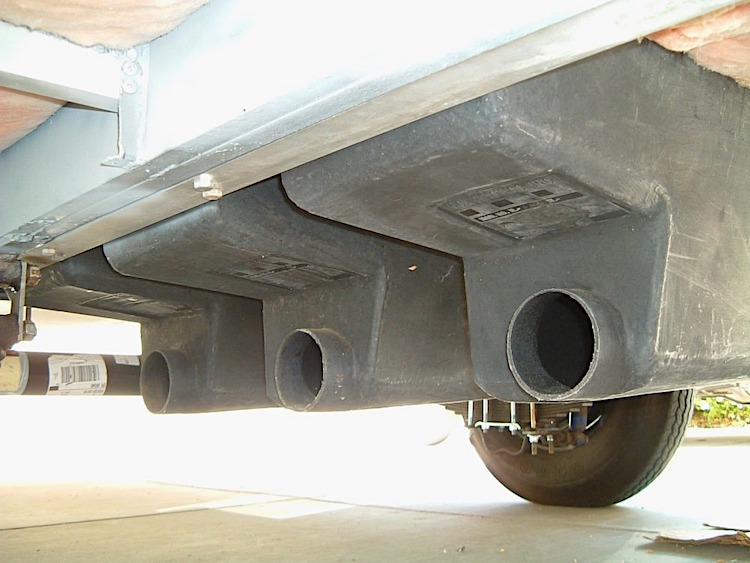
For the most part, there are two types of RV holding tanks; black water and gray water. Blackwater RV holding tanks are where sewage and otherwise “dirty” water is stored. Gray water holding tanks for RVs, on the other hand, are where the non-sewage water (such as the water from RV’s kitchen sink’s drain) is collected and stored.
Blackwater is definitely the more problematic holding tank as it contains raw sewage. For that reason, when flushing their tanks, many RVers save these bad boys for last. Some RVers even religiously flush their black water tanks and hoses with their gray water to help remove the blockage and unwanted leftover black water residue.
To learn even more about RV holding tanks, check out our article called What Are RV Holding Tanks and How Do They Work?
How Long Can You Leave Black or Gray Water in an RV?
Generally speaking, the black water tanks on RVs last for approximately 5 to 7 days while camping. For families or groups, the tanks will last much less (closer to 2 or 3 days). However, your RV’s black tanks can be modified/extended to hold larger capacities.
Speaking of which, you should dump your black tank every 3 or 4 days to once per week when actively using your RV. Doing so more frequently doesn’t allow enough time for the solid waste to break down into more easily manageable (and drainable) sewage.
All things considered, the black water tank should be flushed each time the RV is moved. That means in between camping sites as well as before/after heading home from the road.
The gray water is another story. Gray water tanks are capable of storing fresh water for upwards of two weeks at a time. But, that really just depends on your RV, tanks, and water usage habits.
Final Words About How to Clean a RV Black Tank
Creating a routine with your RV’s black water system is the best way to prevent damage, reduce odors, and avoid costly repairs.
Using a reliable, effective technique, regularly rinse, clean, and sanitize your RV black water tank and purchase the highest quality chemicals you can afford. Always use special toilet paper and avoid flushing other materials down the toilet.
Abiding by these guidelines will help maintain the integrity of your tank while creating a much better experience for both you and your passengers.
Related Reading:
– What Are RV Holding Tanks and How Do They Work?
– Can I Dump RV Tanks at Home?
– How to Combine RV Black and Gray Water Tanks
– Is Special RV Toilet Paper Really Needed in an RV?
Mike Scarpignato – Bio
Mike Scarpignato created RVBlogger.com over five years ago in 2018 to share all we have learned about RV camping.
Mike is an avid outdoorsman with decades of experience tent camping and traveling in his 2008 Gulf Stream Conquest Class C RV and 2021 Thor Challenger Class A motorhome.
We attend RV Shows and visit RV dealerships all across the country to tour and review drivable motorhomes and towable trailers to provide the best evaluations of these RVs in our blog articles and YouTube videos.
We are 3/4-time RVers who created RVBlogger.com to provide helpful information about all kinds of RVs and related products, gear, camping memberships, tips, hacks and advice.


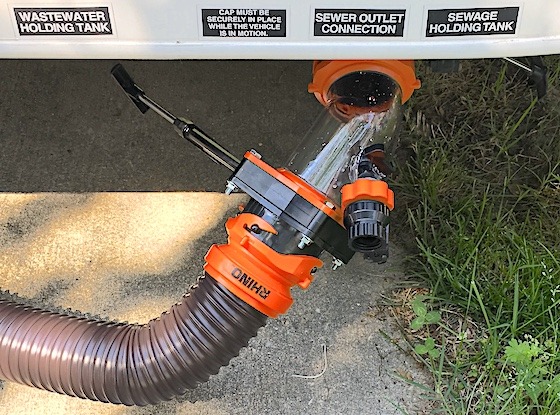
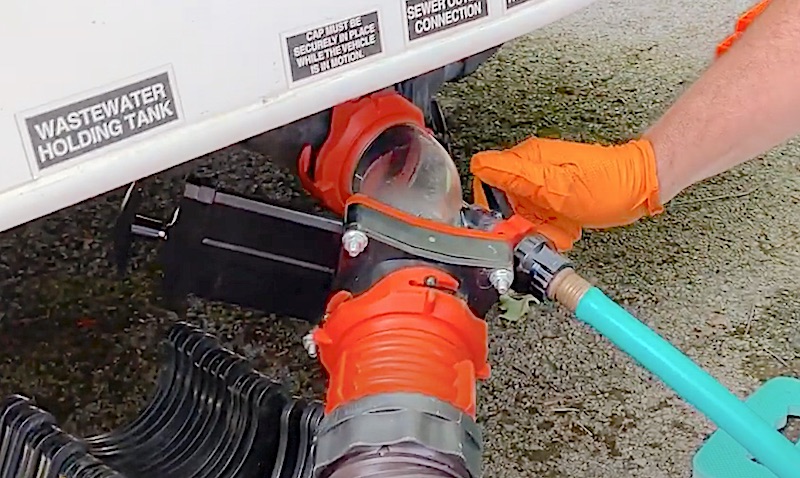
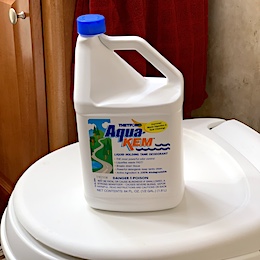
I have this problem with my rv, when I open the water the sigs and toilet flush ok, but the bath tube the water do not want to flush out the water because any time I use the water all the water goes in to my bath tube and stay there like block
In a 2/3 full black tank, add a 10 pound bag of ice, then drive around. That has cleared our sensors before.
I’m an experienced RV’er and have been RV’ing since 1975. I’ll just add a few ideas I have picked up over the years. First of all, don’t empty your black tank each day if you are staying multiple days at a campground. Connect your hose and keep both tank valves closed. (You will use the grey water to wash the hose when dumping.) Keeping the black tank closed and only dumping every few days or more will allow more water to build up in the tank. I would recommend opening your grey tank first for a few seconds to be sure you have no leaks. Close it, dump the black water, close the black valve, open the grey valve and dump the sink and tub water. This contains soap and will help wash the drain hose. When you return home after a trip, use the wand to fully clean the black tank after dumping. I put chemical in everyday to avoid odors and break up black water contents. Always keep a little water in the toiler over the flush valve. Most importantly, be sure you check all connections well and tug on them a little bit to assure everything is going to work prior to draining tanks. One time, one of the teeth on my dump hose connection broke. This allowed the entire black tank to dump all over the ground. We use Angel Soft toilet paper which can be purchased at Walmart. It is cheaper, easier to obtain, and better quality than RV paper. It biodegrades just like RV paper. If a little undisolved paper washes down your hose into the sewer at the dump station, don’t worry about that. After all it is going into a sewer or septic tank. While I am draining tanks outside, my wife cleans the toilet and puts in the chemical in the toilet. Another tip I use is to lay out a rug before connecting the hose, then moving it prior to draining. (It help save the knees.) Finally, install a sewer cleanout in your lawn where you can easily drain your hoses at home. It should be near a driveway. Happy RV’ing!
Thanks! Had a tent trailer for years and just stepped up to a 2021 keystone Cougar 29BHS. very intimated by all the bells and whistles, especially the toilet maintenance. Going to watch and buy the products you suggest Mike!
Question…
When black tank is flushed, cleaned and sanitized do we put some water back in it or let it sit dry if it’s going to sit for awhile? We live in Florida so we really don’t have to winterize it.